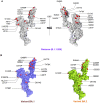A Detailed Overview of SARS-CoV-2 Omicron: Its Sub-Variants, Mutations and Pathophysiology, Clinical Characteristics, Immunological Landscape, Immune Escape, and Therapies
- PMID: 36680207
- PMCID: PMC9866114
- DOI: 10.3390/v15010167
A Detailed Overview of SARS-CoV-2 Omicron: Its Sub-Variants, Mutations and Pathophysiology, Clinical Characteristics, Immunological Landscape, Immune Escape, and Therapies
Abstract
The COVID-19 pandemic has created significant concern for everyone. Recent data from many worldwide reports suggest that most infections are caused by the Omicron variant and its sub-lineages, dominating all the previously emerged variants. The numerous mutations in Omicron's viral genome and its sub-lineages attribute it a larger amount of viral fitness, owing to the alteration of the transmission and pathophysiology of the virus. With a rapid change to the viral structure, Omicron and its sub-variants, namely BA.1, BA.2, BA.3, BA.4, and BA.5, dominate the community with an ability to escape the neutralization efficiency induced by prior vaccination or infections. Similarly, several recombinant sub-variants of Omicron, namely XBB, XBD, and XBF, etc., have emerged, which a better understanding. This review mainly entails the changes to Omicron and its sub-lineages due to it having a higher number of mutations. The binding affinity, cellular entry, disease severity, infection rates, and most importantly, the immune evading potential of them are discussed in this review. A comparative analysis of the Delta variant and the other dominating variants that evolved before Omicron gives the readers an in-depth understanding of the landscape of Omicron's transmission and infection. Furthermore, this review discusses the range of neutralization abilities possessed by several approved antiviral therapeutic molecules and neutralizing antibodies which are functional against Omicron and its sub-variants. The rapid evolution of the sub-variants is causing infections, but the broader aspect of their transmission and neutralization has not been explored. Thus, the scientific community should adopt an elucidative approach to obtain a clear idea about the recently emerged sub-variants, including the recombinant variants, so that effective neutralization with vaccines and drugs can be achieved. This, in turn, will lead to a drop in the number of cases and, finally, an end to the pandemic.
Keywords: Omicron: sub-lineages; disease severity; transmission and infection.
Conflict of interest statement
The authors declare that they have no competing interests.
Figures










References
Publication types
MeSH terms
Substances
Supplementary concepts
LinkOut - more resources
Full Text Sources
Other Literature Sources
Medical
Miscellaneous

